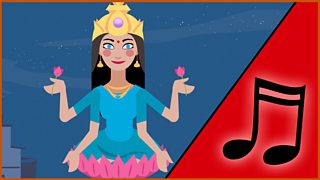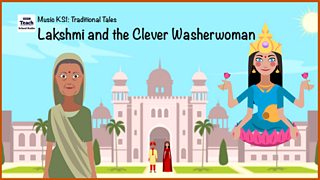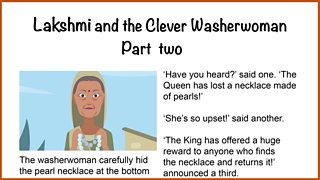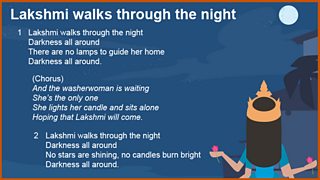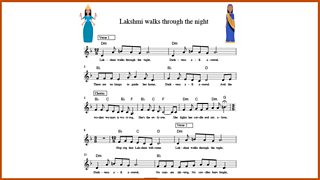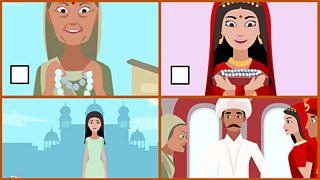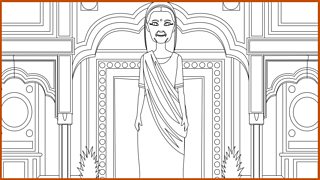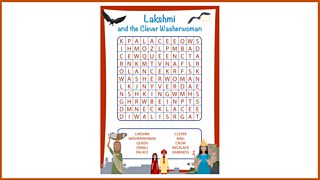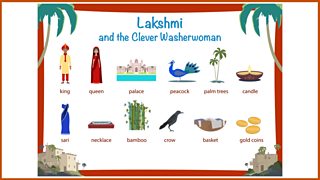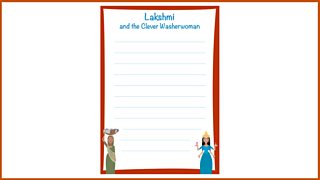Lakshmi and the Clever Washerwoman. 2: Lakshmi walks through the night
In the second part of the story the washerwoman returns the necklace to the palace and insists on a very unusual reward. The song follows Lakshmi on her journey to the washerwoman's village at Diwali. The music activity focuses on pitch and jumping from low to high, while the listening music to appraise is an extract from Erik Satie's famous Gymnopédie No 1.
Tutorial: Learn the song 'Lakshmi walks through the night'
Join Andy and Rebecca to learn the song.

The main elements of the tutorial are:
- Identifying the tempo (speed) of the song: it is slow.
- Looking at how the style is smooth and flowing (legato), helping to build the mysterious, dream like atmosphere.
- Identifying how at the beginning of each verse the music jumps from low to high.
- Understanding how the music climbs up, step, by step, in the third line of the chorus.
- Watching out for the rest at the end of the third line of the chorus.
- Identifying which lines are the same and which lines are different in Verse 2 compared to Verse 1.
- Identifying how the music gets quieter and quieter at the end of Verse 3.
Duration: 08 57
Story: Lakshmi and the Clever Washerwoman, Part 2
The washerwoman returns the necklace to the palace. The Queen is delighted to have it back but when the King offers the washerwoman money as a reward she refuses asking instead that only she be allowed to put out a candle light that night for Diwali.

Darkness falls and the goddess Lakshmi walks through the land, but there are no lamps to light her way - none except the solitary light outside the home of the poor washerwoman. The washerwoman welcomes Lakshmi to her home and is rewarded with happiness and prosperity for generations to come.
Story questions:
- What does the washerwoman ask of the King as her reward? (Forbid anyone from lighting a Diwali light except her).
- Why is Lakshmi sad as she walks through the land? (There are no lights to guide her way).
- What reward does Lakshmi give the washerwoman?
Duration: 05 36
Song: Lakshmi walks through the night
Sing the song with Andy and Rebecca. The clips carousel begins with the full vocal version of the song and is followed by individual clips for Verse 1 and Chorus, Verse 2 and Chorus and then the final sections of the song, beginning with Lakshmi's words 'Where are all the people?' The final clip is the backing track version of the song at the end. This allows you to navigate quickly to the individual sections of the song and to focus on specific sections while learning it.
for the Lyrics. for the Music.
Music activity
Focus: Pitch - jumping from low to high / Pitch - changing the order of our notes to make different patterns / Singing in two parts / Singing as a round

- Andy and Rebecca sing through the first line of the song pointing out how the music jumps from low to high. The children copy.
- Andy and Rebecca change the order of the notes, so that ‘Laskshmi walks through the night’ now has a different note pattern.
- Then the presenters sing different note patterns to this line and the children copy.
- Then they sing the second line of the song - ‘Darkness all around’ - and the children copy.
- Then they change the order of the notes of this line and make up new musical note patterns.
- Finally the class divides into two groups to sing Verse 1 as a round.
Duration: 05 28
Listening music: Erik Satie - 'Gymnop茅die No 1'
Extract from Gymnopédie No 1 by Satie, arranged by Claude Debussy. Published 1888.
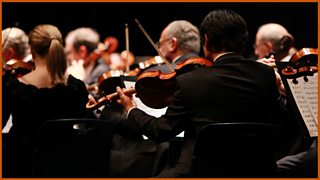
- What is the style of this music? (It is gentle and dream-like, rather like today’s song).
- It was written over one hundred years ago by a composer called Erik Satie.
- The group of musicians playing this piece is called an orchestra.
- Is the tempo fast, or slow? (It is slow).
- Are the dynamics loud or quiet? (Quiet).
- Some instruments have solos in this piece - that means they play a special part on their own, that stands out above the orchestra. In this extract the instrument called an oboe has the first solo. It's an instrument from the woodwind family. Let the children see pictures of these instruments.
Duration: 01 16
Resources
-
![]()
Guidance on all the content (pdf)
-
![]()
Download / print the illustrated transcript of Episode 2 (pdf)
-
![]()
Download / print the lyrics for 'Lakshmi walks through the night' (pdf)
-
![]()
Download / print the music for 'Lakshmi walks through the night' (pdf)
-
![]()
Sequence the events of the story (pdf)
-
![]()
Download / print Lakshmi to colour in (pdf)
-
![]()
Download / print the washerwoman, now rich, to colour in (pdf)
-
![]()
Download / print the word search puzzle (pdf)
-
![]()
Download / print the vocab sheet (pdf)
-
![]()
Download / print the writing sheet (pdf)

